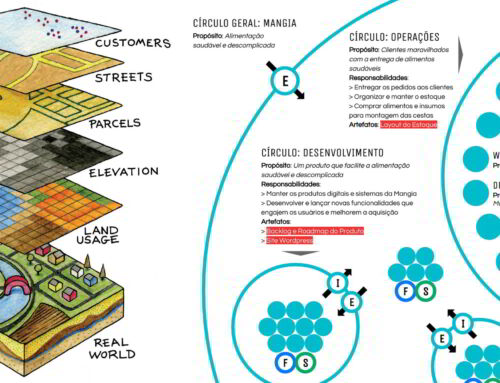The Organic Organization’s way of synchronizing is not just a meeting to resolve a list of tensions raised by the participants. This simple ritual can be enhanced with powerful questions asked by the facilitator that lead participants to take responsibility for their perceptions and act on them. In this text I describe the “Powerful Questions” pattern, widely used in the beginning of the Synchronize practice.
To learn more about Organic Organization, checkout this page or download the ebook.
Context
A circle that is starting to practice the synchronizing mode in O2 and that still has habits or remnants of the old power structure, be it to obtain group appreciation (consensus) or appreciation of the old boss.
Strengths
Some anti-patterns usually manifest themselves during synchronize mode, which generally represent already acquired habits or an organizational culture incompatible with self-accountability. The idea that “Everything belongs to everyone” leads individuals to transfer their responsibility to the group, which is an abstract entity and incapable of taking action. The search for everyone’s consensus or appreciation before taking action can be so frequent that it leads to an exponential increase in the list of tensions and therefore makes the circle meeting the only space to solve problems, even in a dysfunctional way.
Another anti-pattern involves personalization, that is, requests are addressed to people rather than roles in the circle. This increases the frequency of heroic acts (when participants act out of their roles or break Meta-Agreements) and blinds the circle to organizational structure, leading everyone to unconsciousness of established agreements.
Finally, the anti-pattern “Perfect that never gets done” (not yet described) may also be present, where the group fails to take the next step and gets stuck in an endless discussion.
Problem
We need an effective synchronizing way, able to make people reflect on their habits and invoke the defined organizational structure. We need to stop attributing everything to everyone and take responsibility for our perceptions and tensions.
Solution
During sync mode, the facilitator can use one or more of the “Powerful Questions” to reveal any anti-pattern present or help the participant who is dealing with their tension find a way.
To start each item on the list of tensions, the facilitator can ask:
A) What is your tension? What do you need?
Both questions focus on who is feeling the tension, seeking to hold the person accountable and also reducing the participant’s chance of manifesting the anti-pattern “Everything belongs to Everyone“. The questions also invite the participant to express their individual needs and center their perspective on what they see or perceive.
When the discussion reaches a point where it appears that participants are trying to find a perfect solution to the tension, perhaps the group is manifesting the anti-pattern “Perfect that never gets done.” In this case, two questions might be valuable:
B) What is the next step? What is the simplest project or action that can help you move forward?
These questions introduce the participant who brought the tension that it is not necessary to seek a perfect solution to the problem at hand. What matters is taking the next step. Some participants believe that the circle meeting is the only time for “official” interaction between the members of the circle, so they end up wanting the entire circle for a moment. This anti-standard can be intensified by “Everything belongs to everyone”, when in addition to looking for a perfect solution, the requirements still need it to be approved or appreciated by the group.
To reveal the current structure and show participants that what matters are the role agreements, circles and restrictions already defined, the facilitator can use:
C) Which role has the authority to decide this? Is there any role that takes care of this today?
D) Are there any artifacts or restrictions that prevent your action?
E) Are you waiting for someone to do this?
The focus in this case is to help the participant make a clear request. The first step is to check what the structure says about the request. If there is already a role that takes care of that, just send the request to that role. If he’s from another circle, the Internal Link can help to do that. If there is no role, the facilitator can help the participant ask for a heroic act or propose a responsibility or new role in adapt mode.
If everything indicates that it is the participant who has an accountable role, the facilitator can check what he or she wants to do:
F) Given that you have the authority to do this, what do you need?
G) Would you like to consult or hear people’s opinions?
These two final questions prevent the participant from transferring their responsibility to others. Even though they have the responsibility to do something, anyone can ask for help or advice. But this must be made explicit, to avoid projecting his or her dissatisfaction into the group.
In asking all these questions, the facilitator should seek to accommodate the tension and needs of the participant in question. It is important not to disqualify his or her perception, or worse, to dismiss the tension brought about as “inadequate”. There are no inappropriate tensions, only more or less effective strategies to deal with them within O2.
Triggers
Some triggers can be useful for the facilitator to notice when the group demands the use of one or another powerful question. But beware! This is not a cake recipe. It is always necessary to analyze the context.
Powerful Questions:
A) What is your tension? What do you need?
B) What is the next step?
C) Who has the authority to decide this?
D) Are there any artifacts or restrictions that prevent your action?
E) Are you waiting for someone to do this?
F) Given that you have the authority to do this, what do you need?
G) Would you like to consult or hear people’s opinions?
Triggers:
- When starting a tension: A
- When the participant’s request is not clear: A
- When the discussion is prolonged and there is no referral: B
- When former managers are mentioned: C
- When the participant uses the first person plural, as in the lines “we need to decide this” or “we have to do something”: C
- When the participant mentions the group and seeks consensus: C
- When the participant assumes that he does not have autonomy: D
- When the participant seeks someone to do something that is not yet explicit: E
- After verifying that the participant has the autonomy to perform something he was asking for: F
- When the participant seeks consensus, despite having the autonomy to execute the request: G
Resulting Context
Using “Powerful Questions”, circles tend to gain more awareness of their agreements and habits. Constantly referencing the organizational structure also leads to the refinement of roles, circles, and restrictions, and has the potential to reduce the number of heroic acts. The dark side of the previous power structure diminishes due to the strengthening of new agreements.
Rationale
Some of these questions are derived from Holacracy’s “Tactical Meeting” practice. Others – like the one that questions the next step – are highly influenced by David Allen’s Getting Things Done method.
Known uses
This pattern is practiced in almost all organizations that begin their journey using Organic Organization.
Translated by Tanya Stergiou






Leave A Comment